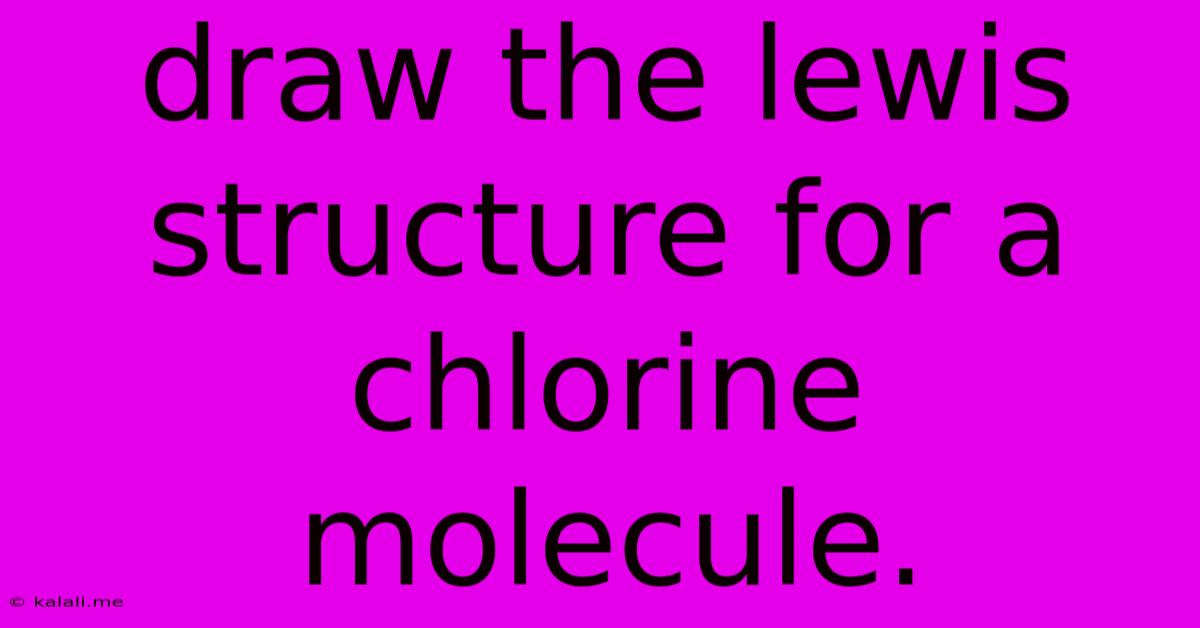Draw The Lewis Structure For A Chlorine Molecule.
Kalali
Jun 16, 2025 · 3 min read

Table of Contents
Drawing the Lewis Structure for a Chlorine Molecule (Cl₂)
This article will guide you through the process of drawing the Lewis structure for a chlorine molecule (Cl₂), explaining the steps involved and the underlying principles of chemical bonding. Understanding Lewis structures is fundamental to comprehending the behavior and properties of molecules. This tutorial will cover everything from identifying valence electrons to understanding the significance of the final structure.
What is a Lewis Structure?
A Lewis structure, also known as a Lewis dot diagram, is a simplified representation of a molecule's valence electrons and their arrangement around the atoms. It helps visualize the bonding between atoms and predicts the molecule's shape and properties. It's a crucial tool in chemistry for understanding molecular geometry, polarity, and reactivity.
Steps to Draw the Lewis Structure of Cl₂
-
Determine the Total Number of Valence Electrons: Chlorine (Cl) is in Group 17 (or VIIA) of the periodic table, meaning each chlorine atom has 7 valence electrons. Since we have two chlorine atoms in a chlorine molecule (Cl₂), the total number of valence electrons is 7 * 2 = 14.
-
Identify the Central Atom: In a diatomic molecule like Cl₂, there's no central atom. Both chlorine atoms are equivalent.
-
Connect the Atoms with Single Bonds: Connect the two chlorine atoms with a single bond (a line representing two electrons shared between the atoms). This uses 2 of the 14 valence electrons.
-
Distribute the Remaining Electrons: We have 12 electrons left (14 - 2 = 12). Distribute these electrons around the chlorine atoms to satisfy the octet rule (each atom aims to have 8 electrons in its valence shell). Each chlorine atom needs 6 more electrons (8 - 2 = 6) to complete its octet. We can add three lone pairs (pairs of dots representing non-bonding electrons) around each chlorine atom.
-
Verify the Octet Rule: Check if all atoms satisfy the octet rule. In this case, each chlorine atom has 8 electrons (2 from the bond and 6 from the lone pairs).
The Completed Lewis Structure of Cl₂
The final Lewis structure for Cl₂ looks like this:
Cl - Cl (where each Cl atom is also surrounded by three lone pairs of electrons, typically shown as dots around the Cl symbol)
Understanding the Bond in Cl₂
The single bond between the two chlorine atoms represents a covalent bond. Each chlorine atom shares one electron with the other, achieving a stable electron configuration similar to that of a noble gas (argon). This sharing of electrons is what holds the molecule together.
Significance of the Lewis Structure
The Lewis structure of Cl₂ allows us to understand its properties:
- Nonpolar: Because both chlorine atoms have the same electronegativity, the electron pair in the bond is shared equally, resulting in a nonpolar molecule.
- Gas at Room Temperature: The relatively weak intermolecular forces between Cl₂ molecules, due to its nonpolar nature, lead to its existence as a gas at room temperature.
- Reactivity: While relatively unreactive compared to some other elements, Cl₂ can participate in chemical reactions, often involving the breaking of the Cl-Cl bond.
This step-by-step guide provides a clear understanding of how to draw the Lewis structure for a chlorine molecule. Remember, mastering Lewis structures is crucial for understanding chemical bonding and molecular properties in chemistry. Practice with other molecules to reinforce your understanding of this fundamental concept.
Latest Posts
Latest Posts
-
How To Create Clickable Image In Html
Jun 16, 2025
-
What Are The Factors Of 121
Jun 16, 2025
-
What Is A Theme Of The Passage
Jun 16, 2025
-
A Company That Provides Access To The Internet
Jun 16, 2025
-
Which Word Is Closest In Meaning To The Underlined Word
Jun 16, 2025
Related Post
Thank you for visiting our website which covers about Draw The Lewis Structure For A Chlorine Molecule. . We hope the information provided has been useful to you. Feel free to contact us if you have any questions or need further assistance. See you next time and don't miss to bookmark.